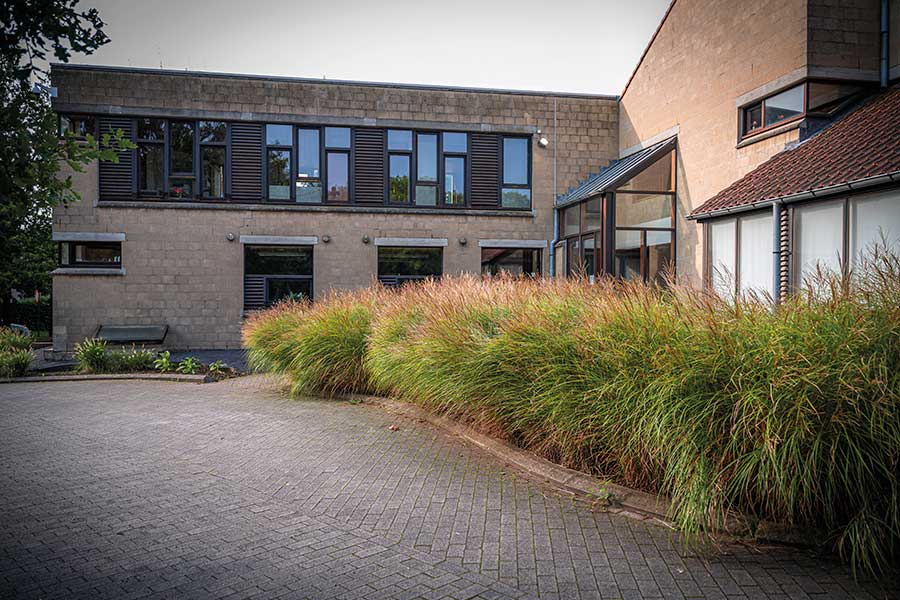Innovation in Practice
Belgium
The detention house project represents a fundamental switch in the Belgian penal landscape. Whereas traditional prisons are large-scale institutions focused on containment, control, and static security, detention houses opt for dynamic security through a small-scale, person-centred, and restorative approach. In this model, detention is no longer seen solely as a deprivation of liberty, but as an opportunity for personal change, support, and sustainable reintegration into society.
1. Small-scale structure and proximity
Each detention house accommodates up to 60 residents, divided into smaller living groups. enabling more intensive, tailored support. The smaller scale creates a more humane, community-like environment, allowing detention to resemble everyday life more closely. Residents are encouraged to take active steps toward their future, engaging in work, education, and rebuilding personal relationships as they prepare for life after detention.
2. Person-centred guidance
In detention houses, the individual is central. Residents are not treated as numbers in a system, but as people with their own strengths and challenges. Together with the support team – personal officers, social workers, psychologists, administrative staff, and management – they work on personal growth. The team actively helps identify and nurture each person’s potential while seeking constructive solutions to their difficulties.
Each resident is responsible for their own detention plan, giving them with the autonomy to prepare for their future. This sense of responsibility also supports their development.
At the same time, they are not left to navigate this alone; they receive intensive, round-the-clock support from a dedicated team. While this approach, where residents sometimes feel “closely monitored,” is often challenging, it lays a vital foundation for personal development.
3. Local anchoring and partnerships
Detention houses are deeply embedded in the local context. We work closely with municipalities, employers, civil society organisations, and residents. These partnerships create a broad and sustainable support network around each house, improving access to employment, housing, and post-release guidance. Rather than isolated facilities, detention houses become integrated parts of their communities, enhancing social cohesion and public support.
Though innovative, detention houses are not temporary pilot projects. They are now structurally embedded within the national penal framework, under the Directorate-General of Penitentiary Institutions. A legal framework has been created, dedicated staff roles have been developed, and preparations are underway to expand the model to other target groups, including youth, older adults, and individuals with substance use challenges. This proves that the model is both scalable and built to last.
The project’s strength lay in its collaborative foundation. Professionals from different fields came together, sharing expertise and learning from both successes and setbacks. As a result, the first detention houses are now up and running, and expansion is underway.
A survey of 38 residents revealed recurring needs in housing, employment, mental health, and addiction care. Internal monitoring for the period November 2023 to October 2024 recorded 150 residents overall, of whom 82 received structured guidance: an average of 1.6 of these life domains addressed in short, focus-specific trajectories and 3.7 areas of support in intensive, multi-issue trajectories.
These early findings confirm that tailoring reintegration plans and ensuring continuity of support from inside to outside detention is complex, yet promising in the following areas:
Reintegration and responsibility
A significant impact is seen in social reintegration. By giving residents responsibility for their own detention plan – as well as daily responsibilities within the house, such as cooking, maintaining living spaces, and participating in volunteer work – they gain greater autonomy and self-reliance. This progress is evident through individual follow-up, progress reports, and reintegration plans developed jointly by residents and support staff.
Reduction of recidivism
One of the project’s core objectives is to reduce recidivism. While long-term data is still being collected, early internal evaluations indicate a positive trend. Residents benefit from tailored guidance, close cooperation with social services and local actors, and targeted preparation for housing and employment. The effectiveness of this approach is being studied by several universities and will be further evaluated using recidivism rates over time, as well as qualitative research conducted by, among others, the National Institute for Criminalistics and Criminology (NICC).
Community engagement
Detention houses are deliberately embedded in local neighbourhoods to foster stronger community ties. Initiatives such as joint activities and open communication with residents have led to greater acceptance and mutual understanding. For example, the detention house in Kortrijk organised “the longest cake table,” a community event that brought neighbours and residents together. This initiative won the 2024 Matexi Public Award, recognising impactful neighbourhood projects.
Employment and education
An increasing number of residents transition into jobs, internships, or volunteer roles during or after their stay. This is closely monitored in partnership with the Flemish employment service, local employers, and through individualised support programmes. These work experiences play a critical role in ensuring a more stable return to society and lowering the risk of reoffending.
Beyond practical reforms, detention houses are contributing to a broader cultural switch in how society views punishment and those who have been incarcerated. They help dismantle stigma and build a vision of justice rooted in restoration, dignity, and second chances.
By aligning detention with reintegration goals and community ties, the model challenges the assumption that confinement must mean disconnection. Instead, it sets a course for a justice system that works in closer step with society – practical, humane, and forward-looking.

Petra Colpaert is the Director of the Kortrijk Detention House, the first detention House of Belgium. She graduated in Criminology from the University of Ghent and worked for 25 years in one of Belgium’s smallest low-security prisons. She began her career as a social worker in the Prison of Ruiselede in 1997, focusing on the rehabilitation of inmates with addiction problems. Since 2010 she has worked as a prison governor with long-term convicted inmates. To help reduce recidivism, she launched the addiction programme B.leave, the training programme ‘Workout’, the volunteer programme ‘Recovery’, and a re-entry house for inmates without social support.

Laurence Nibelle is Director of the Detention Administration Department and Project Leader for the Detention Houses Project at the Belgian Prison Service. She graduated in Criminology from UCL. Laurence began her career as a social worker in the Prisons of Saint-Gilles and Ittre in 2000. She later joined the management team of the National Electronic Monitoring Centre. In 2007, she became a social work inspector in the Central Psychosocial Service. Since February 2021, she has led the Detention Administration Department and oversees the detention houses project. She focuses on aligning detention regimes with security needs and improving prisoners’ reintegration.



